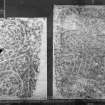Scheduled Maintenance
Please be advised that this website will undergo scheduled maintenance on the following dates: •
Tuesday 3rd December 11:00-15:00
During these times, some services may be temporarily unavailable. We apologise for any inconvenience this may cause.
Inverurie
Pictish Symbol Stone (Pictish)
Site Name Inverurie
Classification Pictish Symbol Stone (Pictish)
Alternative Name(s) Old Inverurie Churchyard; Inverurie Cemetery; Inverury No. 3; Inverurie No. 3
Canmore ID 18875
Site Number NJ72SE 11.03
NGR NJ 7802 2062
Datum OSGB36 - NGR
Permalink http://canmore.org.uk/site/18875
- Council Aberdeenshire
- Parish Inverurie
- Former Region Grampian
- Former District Gordon
- Former County Aberdeenshire
In 2018, Scheduled Monument Consent approved relocation of SM74 (four symbol stones) to within the grounds of SM99 (Bass and Little Bass Motte) and their housing within a glass case display.
The four Class I Pictish symbols stones were previously located 100m west northwest of their present location and are now in a glass display case on The Bass and Little Bass, motte-and-bailey castle (Scheduled Monument SM99). This is located within Inverurie Cemetery.
The stones are believed to have been previously built into the walls of the old parish church, which stood in the northwest corner of the adjacent cemetery. The kirk went out of use in 1775, its walls were used as a source to construct or repair the dykes of the kirkyard in the early 19th century. Three of the symbol stones were later removed from the dykes and while another was rescued when the walls were being constructed. The four symbol stones are now in a glass display case, known as and arranged (from left to right) as; Inverurie numbers 1, 2, 3 and 4.
Reference (1903)
(Inverury no. 3). A fragment of red granite, of rectangular shape, 3ft 4ins (1.02m) by 2ft (0.61m) broad by 1ft (0.3m) thick, sculptured with incised lines on one face: front: at the top the remains of a circle and below this the double disc and Z-rod symbol. The double discs are each ornamented with two concentric circles and a central dot, and the connecting bar with curved lines and small circles and dots in the spaces at each side; the angles of the Z-shaped rod are also ornamented with small circles and dots.
J R Allen and J Anderson 1903.
External Reference (1980)
(Inverurie No. 3). Measuring 1.01m x 0.61m x 0.30m, this fragment is of red granite and bears the remains of a circle and the double disc and Z-rod.
Information from R Jones 1980.
Field Visit (14 August 2000)
(Inverurie no. 3). The Class I symbol stone Inverurie no.3, which bears a circular symbol and a double-disc Z-rod, stands immediately N of no.2. This is also a block of pink granite, trimmed in reuse as building material, but it is now set upright in the ground. It measures at least 0.75m in height, by 0.62m in breadth and 0.28m in thickness, and the top has been broken obliquely, giving it a lectern-like appearance. The face and reverse of the stone are smooth, but the two sides have been roughly trimmed, most obviously on the right, where the edge of one of the symbols has been lost.
At the top of the face an incised line defines the lower edge of the circular symbol, the remainder of which is now lost. Assuming the stone is the correct way up, this may be, as Mack suggests, a disk symbol. Alternatively, if the stone is inverted, it may be the upper edge of a mirror. The double-disk and Z-rod symbol is set below the disk, and its right-hand disk has been lost to the trimming of the sides. Each disk comprises an outer rim, and a inner disk with a central dot (the left hand disk is off-centre to the left). The joining bar is concave-sided, and is also defined by parallel lines, the lanes of which coalesce at the centre. The splayed ends contain oval, or tear-drop shaped pellets, with central dots that echo the ornament of the disks.
The upper arm of the Z-rod is floriated, three reverse-S shaped scrolls rising from its upper edge, and two dropping from the lower. The angles of the rod again contain a rounded pellet with a central dot. The lower terminal of the Z-rod is mutilated by a gash that cuts up into the lower edge of the left disk, but it appears to have a narrow, leaf-shaped 'blade'. The right hand edge of the gash may preserve the incised line of decorative spines on each side of the rod.
Visited by RCAHMS (IF), 14 August 2000.
A Mack 1997.






















